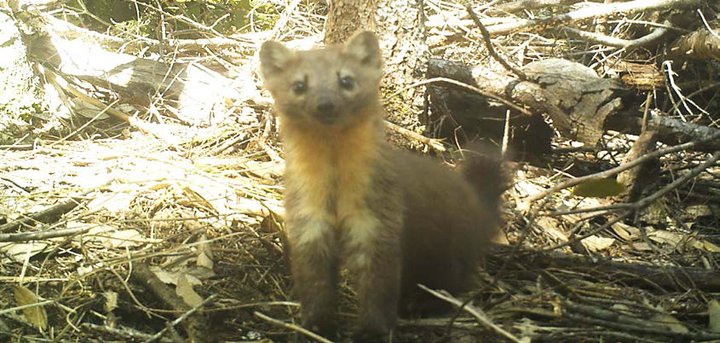
Humboldt marten. Photo: Charlotte Eriksson, Oregon State University. Via Center for Biological Diversity.
DOCUMENT:
- ”Report to the Fish and Game Commission: A Status Review of the Humboldt Marten (Martes caurina humboldtensis) in California,” California Department of Fish and Wildlife. June 2018.
###
Press release from the Environmental Protection Information Center:
The California Department of Fish and Wildlife is recommending that the Humboldt marten, also known as the coastal marten, be listed as an endangered species under the California Endangered Species Act. This recommendation is in response to a listing petition filed in 2015 by the Environmental Protection Information Center (EPIC) and the Center for Biological Diversity. The California Fish and Game Commission will make a final decision on the marten’s listing at their August 23, 2018 meeting in Fortuna, California.
Relatives of minks and otters, Humboldt martens are found only in old-growth forest and dense coastal shrub in southern and central coastal Oregon and northern California. The cat-like animals were thought to be extinct until they were rediscovered on the Six Rivers National Forest in 1996.
“Human activity nearly drove the marten to extinction,” said Tom Wheeler, Executive Director of EPIC. “Because of the marten’s rediscovery, we were given another shot to save the Humboldt marten. We can’t blow it this time. We owe it to future generations and to the Humboldt marten.” Within California, Humboldt martens once occupied the coastal forests from Sonoma County north to the Oregon border. However, a history of habitat loss and trapping for their fur has reduced the marten’s current range to two small areas in Del Norte, Humboldt, and Siskiyou counties.
Scientists estimate that California’s population numbers less than 200 individuals. The Department found that the marten is endangered because of this very low population number combined with the threats posed by habitat loss from logging, urbanization, cannabis cultivation, elevated predation rates, exposure to toxicants and diseases, and climate change.
Martens are typically 2 feet long and have large, triangular ears and a long tail. They eat small mammals, berries and birds and are eaten by larger mammals and raptors.
CLICK TO MANAGE